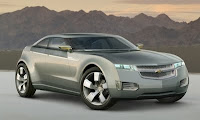Chevy Volt
 August 11, 2009 (AP) – General Motors Corp. said Tuesday its Chevrolet Volt rechargeable electric car should get 230 miles per gallon (98 kilometers per liter) of gasoline in city driving, more than four times the current champion, the Toyota Prius.
August 11, 2009 (AP) – General Motors Corp. said Tuesday its Chevrolet Volt rechargeable electric car should get 230 miles per gallon (98 kilometers per liter) of gasoline in city driving, more than four times the current champion, the Toyota Prius.The Volt is powered by an electric motor and a battery pack with a 40-mile (65-kilometer) range. After that, a small internal combustion engine kicks in to generate electricity for a total range of 300 miles (480 kilometers). The battery pack can be recharged from a standard home outlet.
GM is marketing the 230-mile (370-kilometer) figure following early tests using draft guidelines from the U.S. Environmental Protection Agency for calculating the mileage of extended range electric vehicles.
The EPA guidelines, developed with guidance from automakers, figure that cars like the Volt will travel more on straight electricity in the city than on the highway. If a person drives the Volt less than 40 miles (65 kilometers), in theory they could go without using gasoline.
Highway mileage estimates — which are generally higher than city ones — for the Volt have yet to be released using the EPA's methodology.
"We are confident the highway (mileage) will be a triple-digit composite," GM CEO Fritz Henderson said.
If the figure is confirmed by the EPA, which does the tests for the mileage posted on new car door stickers, the Volt would be the first car to exceed triple-digit gas mileage.
EPA said in a statement Tuesday that it has not tested a Volt "and therefore cannot confirm the fuel economy values claimed by GM." The agency said it applauded "GM's commitment to designing and building the car of the future — an American made car that will save families money, significantly reduce our dependence on foreign oil and create good-paying American jobs."
GM has produced about 30 Volts so far and is making 10 a week, CEO Fritz Henderson said during a presentation of the vehicle at the company's technical center in the Detroit suburb of Warren.
Henderson said charging the volt will cost about 40 cents a day, at approximately 5 cents per kilowatt hour.
Most automakers are working similar plug-in designs, but GM could be the leader with the Volt, which is due in showrooms late in 2010.
Toyota's Prius, the most efficient car now sold in the U.S., gets 48 miles per gallon (20 kilometers per liter) of gas. It is a gas-electric hybrid that runs on a small internal combustion engine assisted by a battery-powered electric motor to save gasoline.
Although Henderson would not give details on pricing, the first-generation Volt is expected to cost near $40,000, making it cost-prohibitive to many people even if gasoline returns to $4 per gallon.
The price is expected to drop with future generations of the Volt, but GM has said government tax credits of up to $7,500 and the savings on fuel could make it cost-effective, especially at 230 miles per gallon (98 kilometers per liter).
"We get a little cautious about trying to forecast what fuel prices will do," said Tony Posawatz, GM's vehicle line director for the Volt. "We achieved this number and if fuel prices go up, it certainly does get more attractive even in the near-term generation."
Figures for the Volt's combined city/highway mileage have not yet been calculated, Posawatz said. The combined mileage will be in the triple digits as well, he said, but both combined and highway will be worse than city because the engine runs more on longer highway trips.
The mileage figure could vary as the guidelines are refined and the Volt gets further along in the manufacturing process, Posawatz said.
GM is nearly halfway through building about 80 Volts that will look and behave like the production model, and testing is running on schedule, Posawatz said.
Two critical areas, battery life and the electronic switching between battery and engine power, are still being refined, but the car is on schedule to reach showrooms late in 2010, he said.
GM is simulating tests to make sure the new lithium-ion batteries last 10 years, Posawatz said, as well as testing battery performance in extremely hot and cold climates.
"We're further along, but we're still quite a ways from home," he said. "We're developing quite a knowledge base on all this stuff. Our confidence is growing."
The other area of new technology, switching between battery and engine power, is proceeding well, he said, with engineers just fine-tuning the operations.
"We're very pleased with the transition from when it's driving EV (electric vehicle) to when the engine and generator kick in," he said.
GM also is finishing work on the power cord, which will be durable enough that it can survive being run over by the car. The Volt, he said, will have software on board so it can be programmed to begin and end charging during off-peak electrical use hours.
It will be easy for future Volt owners living in rural and suburban areas to plug in their cars at night, but even Henderson recognized the challenge urban, apartment dwellers, or those that park their car on the street might have recharging the Volt. There could eventually be charging stations set up by a third-party to meet such a demand, Henderson said.
Chrysler Group, Ford Motor Co. and Daimler AG are all developing plug-ins and electric cars, and Toyota Motor Corp. is working on a plug-in version of its gas-electric hybrid system. Nissan Motor Co. announced last month that it would begin selling an electric vehicle in Japan and the U.S. next year.


Comments